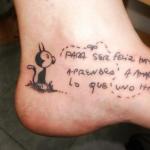Average handwriting speed. How to learn to write quickly and beautifully: useful tips
In our age, writing various documents in manuscript is gradually becoming a thing of the past. When almost everyone has a computer with Word, why waste money on paper and pens? Moreover, in this case, the eternal problem of cutting out with an ax what is written with a pen disappears. But while schools and other educational institutions require students to write tests, homework, dictations and statements in notebooks, the question “how to learn to write quickly” still worries students and schoolchildren. And in “adult” life, various statements, receipts, petitions are accepted written exclusively in one’s own hand.
Basics of fast writing
You will never be able to learn to write quickly if you do not know how to hold a pen in your hands correctly, if you sit slouched at the table, if your hand gets tired quickly. To avoid this, follow the rules:
- Choose furniture suitable for writing: a table and chair with a comfortable backrest. You will never write quickly while sitting on a bed or in a chair, holding a notebook on your haunches. It is best to write at a table that suits your height.
- The body must be kept straight. While sitting at the table, check whether your knees are bent at right angles, what is the distance between your chest and the table (ideally, it is equal to two palms).
- If you want to learn how to write quickly with a pen, choose the “tool” that suits you. At an office supply store, buy several pens with different refills, pens made from different materials, thin and thick. Through trial and error, you will find the pen that suits you. You need to learn to hold the pen correctly, with three fingers, so that it rests on the middle one, and the thumb and forefinger hold it.
- When writing, the sheet of paper must be positioned so that it lies slightly to the right of your torso.
- If your hand gets tired quickly, and you have to write a lot and often, then buy a manual expander that will train your hand.
- Try writing at speed. Set a timer on your watch or mobile phone, for example, for 15 minutes, try to write as much text as possible during this time.
Do you want to learn how to quickly write on a computer in order to earn fame and capital from writing? Well, mastering the computer keyboard and the touch typing method is not so difficult. There are many programs on the Internet that will make you a keyboard ace in a short period of time. But mastery of these programs does not make you a productive copywriter. Follow the advice from the pen masters:
- If you're writing a piece of fiction, make sure you have an outline! It will reduce the time spent thinking about “what to write about next.”
- Be a writer, not a proofreader! Correct errors at the end of the work, not as it progresses.
- Write at speed! Record the time it takes you to write a standard article.
- If you are at a loss, not knowing what to write about next, write whatever comes to mind. Sitting for several hours, thinking about how best to continue your work is not the best way to spend your time.
- When you sit down to write an article, come up with a ritual. For example, a cup of coffee or tea that you can sip while you work.
- Look for places where you can write better. The muse comes to someone when he is sitting all alone at his desk, to someone in a cafe.
- Write on topics that are understandable and interesting to you. Do not try, when working, say, as a copywriter, to write on topics that are far from yours. If you are well versed in psychology and pedagogy, writing an article about concreting a floor will take a long time and be difficult.
Humanity is divided into three unequal groups: right-handers, left-handers and ambidextrous people (people with equally developed hands). Which of them is easier to learn to write quickly with a pen? Scientists have concluded that both left- and right-handed people can write quickly with regular training. The hardest thing is for ambidextrous people. Although they can write with both hands, this ability leads to disasters in everyday life: these people do not control their hands well enough. It is about them that they say “both hands are left.” But both a left-hander and a right-hander, if you make an effort, can easily grow into a productive writer.
Nowadays, despite technological advances, people still have to write by hand. First of all, this concerns schoolchildren and students who are forced to take notes on lectures, submit essays and presentations, and take tests. How to learn to write quickly so that the notes you make can be easily understood? The tips below will help you improve your writing speed in no time.
How to learn to write quickly: choosing a pen
You should not use a pencil, it will only delay the process. The speed with which a student takes notes on lectures largely depends on the pen in his hands at the time. How to learn to write quickly? Through trial and error, acquire the most convenient office supplies. First of all, the handle parameters such as thickness and shape play a role. It is also worth paying attention to the material; the product should not slip out or cause discomfort. The appearance of calluses and rapid fatigue of fingers are signals that the pen is no longer suitable.
Choosing the right pen is only half the battle; how the student holds it is also important. The product should be placed on the middle finger, the index and thumb are used to grip it. The remaining fingers are practically not involved in the process; they should remain in a static and relaxed state. How to learn to write quickly? A mistake is made by people who convulsively squeeze the handle.
Useful exercises
An expander is a useful tool for those who want to significantly improve their writing speed. By the way, exercises with this device are useful not only for this, but also as physical activity. Modern sporting goods stores offer customers not only models for adults, but also products specially designed for children.

How to learn to write quickly? An expander is not the only opportunity to achieve your goal. Modeling from plasticine effectively helps develop fine motor skills. You can sculpt anything you like, for example, small animal figures. The more small details, the more effective this training is. People who don't like fiddling with plasticine can skip it in favor of beading.
Finally, you need to constantly write. Keeping a diary will be an excellent workout; you can simply write down ideas that randomly arise in your head, or put on paper a summary of the books you read. A timer is a great way to monitor your writing speed at such times.
Abbreviations system
Any schoolchild knows about its existence; it would also hardly occur to students to completely write down words like “so on”, “like that”. Everyone knows the principles of reducing units of measurement of volume, length, speed and other quantities. However, for those who are interested in learning how to write quickly with a pen, this is not enough.

Reading scientific literature helps you master the art of shortening text. For example, the name of the subject in articles is used only at the beginning, then only the first letter with a dot is placed. A student can also invent a personal system of abbreviations by devoting some time to this. How to learn to write quickly with a pen? For example, you can remove all letters from a word except the initial and final ones, or use only the first letters.
Of course, entries made using abbreviations must be understandable. If it takes a lot of time to decipher them, it is simply not practical to continue using this method.
A few words about presentations
The system of abbreviations does not come to the aid of the student in all situations. How to learn to quickly write a summary without breaking the rules of grammar? Here, a good memory will come to the aid of the student first of all, therefore, it must be constantly trained. To do this, you can memorize poems, retell books you’ve read aloud, or better yet, write down their summary.
The draft is used at the stage when the student listens to the text on which the presentation is written. It is necessary to record on paper the outline of the story, main thoughts, complex words and expressions. The points do not have to be detailed; they are only required to highlight the main issues. To avoid wasting valuable time thinking about how to spell this or that word correctly, which punctuation mark to choose in this or that case, it is necessary to learn the rules of grammar and punctuation.
A little about handwriting
If lecture notes must first of all be understandable to the author himself, then the presentations and essays are read by inspectors. and fast person in this case? He will learn if he works with the copybooks that were used in the first grade. Having practiced writing each letter, you can begin to write whole words. It is useful to use a squared notebook, trying to write words so that there is only one letter per cell.

Learning to quickly type text on the keyboard is also useful. Any program for training typing speed will help with this. For example, you can use “Keyboard Solo”.
Free typing lessons are included in the complete Learn to Type package. Animated keyboard layout and on-screen hints (hand graphics) are designed to correct typos by showing you the correct way to enter characters during training and practice. The difficulty of the tasks gradually increases, from 2 letters at the beginning of the course to using the entire keyboard. At the end of the lesson, statistics are available: typing accuracy, number of words per minute and number of errors made.
Helpful hints:
- When practicing typing, don't look at the keyboard. Only on the screen.
- Even without looking at the keyboard, you can place your fingers in the basic position - to do this, you need to use your fingertips to find the bulges on the letters A and O.
- The first lessons use a set of letters. And only when your fingers remember the keys do words and sentences appear. This is the best way to learn to type without errors.
- It is important to periodically check your typing speed - an online test will help you monitor your learning progress. Complete tasks over and over again to learn how to quickly type on the keyboard - online lessons are created specifically for this!
Types of exercises aimed at developing cursive writing for students in grades 2–4.
Writing by its nature is a motor act. To put the content of your thoughts on paper, you need to “be able” to write. For the convenience of hand movement while recording thoughts, a written font of the letters of the Russian alphabet was invented. If writing lessons in 1st grade are devoted to mastering this font, then in subsequent grades work continues to achieve legibility letters. Pay attention to the name of the criterion - legibility letters. It is of a communicative nature: if it is written illegibly, you will not be able to extract the meaning of what is stated. Legibility of writing is achieved through exercises aimed at reproducing the exact configuration of letters and their connections.
Particular attention should be paid to such a component of writing skill as speed. The pace of writing is also communicative in nature. Rapid writing allows you to capture fast-moving thoughts more synchronously. When slow, the effect of “thought running away” is observed, which makes it difficult to present the content consistently. It is well known that writing speed is a consequence of the development of fine motor skills, ease, and rhythmic movements of the hand and fingers. The system of exercises to improve writing technique requires the inclusion of special “receipts” to achieve ease, smoothness, and freedom of hand movement both clockwise and counterclockwise. From time to time it is recommended to record short texts for a while. The mere call to write faster will not speed up the hand, and if this happens, then there is often a decline in the level of legibility of the letter: the shapes of the letters begin to resemble each other, due to an irrationally executed connection, the letter combination is distorted and the word becomes unreadable. For example: 1) olo, oro, ovo; 2)g h, n y, sht, b, s e, k p, zh t, i e, ts; 3)yu - go, its - iu, from - sch, and - her, m - le, less - less and so on.; 4) V K N B D(volumes of loop elements). This system of exercises will contribute to the development cursive writing, the vital ability to write soon And legibly.
Measurements of writing skills from the standpoint of cursive writing, legibility and “vigilance of the eye” (control over literacy) made it possible to establish some optimal criteria for the pace of writing of primary schoolchildren. When copying an exercise from a textbook (blackboard), the following indicators for “working” speed (letters per minute) were revealed:
The potential speed for continuous writing is 10–20 letters higher than the “working” speed.
We present reminders methods for measuring writing skills.
1. Memo for measuring “working” speed, legibility, and graphic vigilance of writing.
Measurements are carried out at least twice during the academic year. First, the data is tracked on a type of writing such as copying text from a textbook (typical for Russian language lessons). You can recommend that students keep a special notebook to compare measurement data and monitor the “growth” of their own indicators.
Sequence of work:
1. Explain the goals of the work, what parameters of writing are being monitored (during the first measurement, there is no need to report observations of writing speed).
2. Indicate the exercise in the textbook (there should be no words with missing letters in it, no tasks in the textbook will be taken into account for now), offer to read it silently. Find out if there are any words that are unclear in meaning.
3. Explain the procedure for performing the exercise: start writing to everyone at the same time on the teacher’s command, copy the entire text, then immediately (without checking) raise your hand. Corrections that are allowed during copying should be corrected with the same pen.
4. Observe the passage of time, and as students finish their work, mark down the time spent on completing the exercise for each student under his or her work.
5. After all students have finished cheating, recommend that they carefully check their notes (at the same time, there is an opportunity to observe how the children check). The check is carried out without timing. Errors made during verification are corrected with a pencil or other paste.
6. *This measurement can also reveal the degree of understanding of the meaning of what has been read (written): offer to title the text or underline the sentences in which the main idea is expressed. For the title, you need children to skip a line before the text.
7. When checking works, the following are analyzed: 1) the number of errors and corrections made, error-free works (the level of graphic vigilance and self-control); 2) compliance of the letter with calligraphic requirements; 3) approximate writing speed - the number of letters in one minute (the total number of letters in the text is divided by the time spent); 4) correspondence of the title to the content.
8. Based on the data for each student, the average speed of the class, the number of errors and corrections are calculated, and typical shortcomings are identified.
2. Instructions for measuring potential speed.
It is revealed by recording for 1 minute any phrase or sentence, for example, I I'm in fourth grade. Next, the number of sentences written down during these minutes and the number of letters in them are calculated. The number of letters is divided by the number of minutes. We get writing speed. As a rule, with this type of writing there is a decline in calligraphy, and missing letters are not uncommon. Based on these data, everyone is given the task of “teaching” their fingers to write letter configurations in words, taking into account the speed capabilities of the hand. This is the purpose of the penmanship minutes - the formation of cursive writing.
The results of work analysis can be recorded using a table.
Some recommendations for conducting classes to improve writing techniques (penmanship). Traditionally, 45 minutes a week are allocated for penmanship classes. The teacher himself chooses the time period: either a separate lesson, or three times for 15 minutes, or 5 minutes every lesson. We advise you to take a differentiated approach to the choice of penmanship classes. To get acquainted with a new type of connection, a receipt such as “letters in bundles” with acceleration, you need to allocate up to 12–15 minutes. When practicing (polishing) a technique, writing at a new speed, 5 minutes per lesson is enough. A preparatory “signature” of the hand is possible within 2–3 minutes. It must be remembered that preparing the hand for writing should be carried out immediately before performing written work. And this stage does not necessarily coincide with the beginning of the lesson.
You can come up with games to motivate baby write faster. For example, arrange a small competition - who can quickly write the names of all members of your family, the name of your city, the surname, first name and patronymic of the class teacher baby? Such competitions, if they become a daily practice, will help children write faster. Change tasks every time. Ask him to come up with words for the competition himself. You can use synonyms and antonyms.
Give it back baby to a music school or study music with him on your own. Playing an instrument helps develop finger motor skills. Playing the piano or any stringed instrument is suitable.
Give your child a hand massage - stretch his hands and fingers. Use exercises that musicians use to warm up before playing. For example, the “stretching” exercise - palms are folded together, the fingers of the right hand press on the fingers of the left, “swinging” movements and vice versa.
Even before your child goes to school, you can start practicing quick writing. For example, in the process of drawing. It is important here to instill the skill of quickly controlling a pen or pencil. Start with the simplest shapes. Ask baby draw seven dots, seven squares, seven triangles at speed. At the same time, make sure that he draws all the figures as evenly and correctly as possible, then you will avoid negligence, which can appear when completing the task quickly. You can use a metronome for this exercise. For each stroke, the child must draw a figure; gradually increase the tempo.
Don't be so quick to blame baby in slowness. Perhaps he is in no hurry because he is upset by the ugly letters that come out when writing quickly. On the contrary, encourage his desire to write beautifully, but start doing “acceleration” exercises.
Conclusion.
Writing speed is characterized by the number of letter characters written by a student in a coherent text per unit of time, most often per minute. An increase in the speed of writing indicates that small, isolated acts of writing, when united, turn into a single process of integral reproduction of letter complexes, which proceeds easily, without much expenditure of physical and nervous strength.
Along with speed, the coherence of writing is also formed, which is manifested in the student’s ability to follow the rules for connecting letters and at the same time coordinate the movements of the hand, moving it to the right as integral graphic complexes are drawn. Coherence is characterized by the number of letter characters written continuously, with a single stroke of the pen. It is associated with the development of writing speed and stability of students' handwriting.
To develop clear handwriting in students under conditions of accelerated writing, it is necessary to consolidate skills. To improve the clarity of the shape of letters in writing, to carry out rational, correct connections of letters, to achieve parallelism of strokes and slope in students’ works, to work on maintaining the same and correct height of letters on the line and page. Considering that the speed and clarity of writing largely depends on the rhythm and smoothness of hand movement, the development of these writing qualities in students also continues to be an important aspect of work in penmanship classes.
In Russian language and mathematics lessons, demands increase for an increase in the volume of notes produced, and, consequently, for the speed of writing. Moreover, the requirements for clarity of writing are also not reduced.
Therefore, the teacher needs to continue to work on developing distinct handwriting in students while simultaneously increasing the requirements for increasing writing speed.
Based on research on the mechanism, features of the movement of fingers and hands in the process of accelerated writing, and analysis of typical shortcomings in the handwriting of children of this age, it is possible to identify and specify a number of tasks on the solution of which the formation of clear cursive writing in students depends.
1. To consolidate the correct and rational writing techniques that students develop and improve their handwriting.
2. Develop the ability to write quickly enough while maintaining clarity of writing
3. In the development of writing skills, prevent possible shortcomings associated with deformation and assimilation of letters and letter combinations, and the appearance of carelessness in writing.
4. Correct individual deficiencies in students’ handwriting.
Solving the set tasks can be facilitated by the teacher’s methodological instructions when students perform any written work in class, as well as by organizing specially selected graphic exercises in penmanship classes, which are recommended to be carried out at each Russian language lesson for 8-10 minutes.
A very interesting picture emerges from the previous post. I will now write three posts based on it.
First. Yes, I wanted to find out what the average speed of meaningful writing is for those who consider themselves to be quite fast writers. So that you do not think about the topic, the topic suggests the actual written speech. It would have been possible to give ten minutes, but I didn’t want to torture you; nevertheless, five minutes can easily be allocated. It’s just a pity that many people had more interesting things to say about this.
What became clear with speed. People who considered themselves to write fairly quickly averaged between 200 and 300 characters per minute. Several people showed higher - up to 350-360. The Internet says that for a typist when applying for a job, 120-150 characters per minute is considered a good speed. So ordinary LJ users can do even more :)
Everyone was happy to write in block letters, many got themselves notebooks and little books to write their “essays” there. Many people wanted to learn to write “in writing” even before school. All but one respondent were forbidden and not allowed to do this - otherwise they would have to be retrained at school. It’s interesting that at the moment when the children were interested in it, it seemed attractive to adults, they were not given it. For their benefit? If you look closely, no. Any training in smooth, small movements would benefit them, right? This was “beneficial” only for the school - no unauthorized wandering, everyone learns the handwriting that is prescribed, “relearning” means straining the school.
Did this help anyone a lot? No. Almost everyone said that their handwriting was terrible, they scolded them for copying, and practicing the correct letters was not a pleasure, but a torment. No one is particularly happy with their handwriting or praises it (unlike their typing speed). Several people like beautiful calligraphic handwriting and would like to improve theirs or learn how to do it. Now :) not at seven years old.
That's the amazing thing about this handwriting, isn't it? They drilled everyone, but brought almost no benefit to anyone. Those who write beautifully are those who would write beautifully even without school - because they have an inclination and love for it. I have beautiful handwriting now, I write with pleasure. But it has nothing to do with elementary school. I wrote terribly, I couldn’t write these characteristic strokes, the teacher constantly scolded me, complained to my mother, my mother trained me at the kitchen table. After the initial drill of grades up to the fifth or sixth grade, I had a terrible, angular handwriting, large and covered in triangles. My current handwriting probably appeared after I was fifteen and has remained with me all my life - oval, narrow and round. I can't credit my good handwriting for those first six or seven years of school.
The child was tortured with the same letters in a Russian elementary school. But in the American one - no. They calmly write to themselves in semi-printed letters, a special, more rounded variety; no one appreciates the beauty of the writing at all. And at the end of the third grade, around the age of eight or nine, they begin to gradually learn written letters without fanaticism. On TV they show large-scale how to draw a line here, then there, piece by piece, and the kids repeat it in large copy. Pencil - because it’s easier and smoother to write with. During all the time I studied these letters, I don’t remember someone’s torment or the teacher’s scolding, or the negative feelings of the kids - I’m stupid, I’ll never succeed. Well, somehow, casually, we studied the letter and wrote a page of copybooks.
And what’s interesting is that I have seen very good, solid, beautiful written handwriting in many adults. And among Russian adult acquaintances - very rarely.






